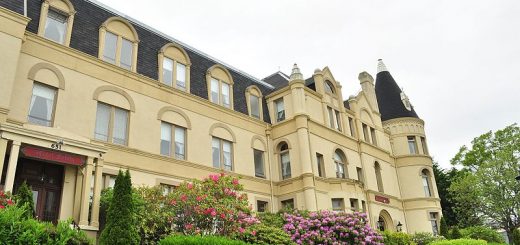Penkaet Castle
Penkaet Castle (which has also been known as Fountainhall, Penkaet House and Woodhead) is a 16th century mansion and would seem to have several ghosts. One of these is generally identified as Alexander Hamilton, a beggar who had approached the castle seeking food and shelter, only to be cruelly turned away. Hamilton threw a curse at the family as he was removed from the property. A few days later Lady Ormiston died of a mystery illness along with her daughter. Hamilton was found, arrested and put on trial for witchcraft. He was found guilty and hanged at Edinburgh Castle for his crime. Apparently, under questioning he had revealed that he had returned to the castle and tied some blue thread on the main doors, which he then used as part of a magic spell to kill the two women. His ghost is said to have been seen waiting at the castle doors.
John Cockburn is also sad to haunt Penkaet in penance for the murder of Mr Deton that he committed there. An apparition of a small man in a cloak is said to exit a cupboard and walk across the full length of a room before leaving through the wall. This apparition is said to be Gentleman John Cockburn. A Sir George Cockburn of Ormiston sold th ehuse and land to the Pringill family in 1635, so this may help date John Cockburn.
Sir Andrew Lauder who’s family who owned Fountainhall between 1685-1922, was said to have witnessed another frightening apparition by a fireplace in one of the upper rooms when he was a young boy. The witness may have been Sir Andrew Lauder of Fountainhall, 5th Baronet (8 May 1702 – 6 Mach 1769) or his son Sir Andrew Dick-Lauder, 6th Baronet (28 April 1743 – 18 November 1820).
There is also a haunted bed that has a link to King Charles I. The bed which had been used by King Charles I and is decorated with a copy of his death mask was presented to Penkaets owner Professor Ian Holbourn, Laird of Foula (5 November 1872 – 15 September 1935) by his students and moved into the castle in 1923. The Housekeeper noticed early on that the bed would often be found with the bedclothes in disarray, as if someone had just been sleeping in it, even though she knew no had been and the bed had been left tidy and made. In 1924 when a guest arrived the house and shown to the room with the King Charles bed, it was already messed up, even though the housekeeper had only left the room tidy a short time beforehand. Other disturbances would also be associated with the bed and the room it occupied. The bed would make noises as someone was sleeping in it and moving around, sometimes even a thud like they had fallen out of bed. These disturbances, the noises and moving bedclothes would even happen when the room was empty and locked. One night the owners dashed to room as they thought they had heard their guest fall from her bed, only to find her fast asleep.
Professor Ian Holbourn was a survivor of the sinking of the RMS Lusitania on 7 May 1915 where his bravery had aided a young 12 year old girl called Avis Dolphin survive. Their story of the sinking can be found here. Miss Dolphin visited Penkaet Castle in 1925 to stay with her friend. She was given the King Charles Room and the haunted bed. Avis thought she heard someone moving around downstairs and went to alert Professor Holbourn and his wife. When they were heading downstairs they both heard noises of somebody moving about in the King Charles I bed, which Avis had just let moments ago. Another incident Miss Dolphin had in the castle was to have a ghostly touch on her neck like a fingertip being drawn across her throat.
Also during 1925 Ian’s wife Marion Holbourn witnessed a shimmering light moving in the passages of the house.




Recent Comments